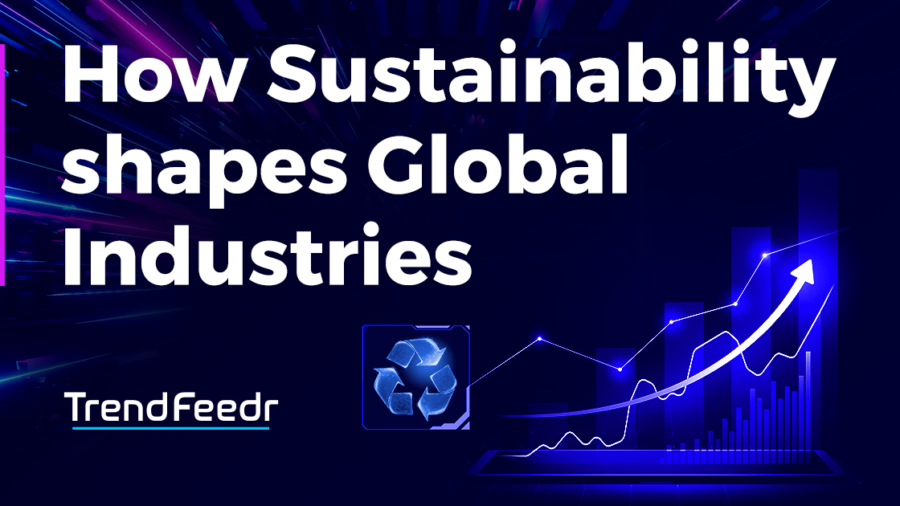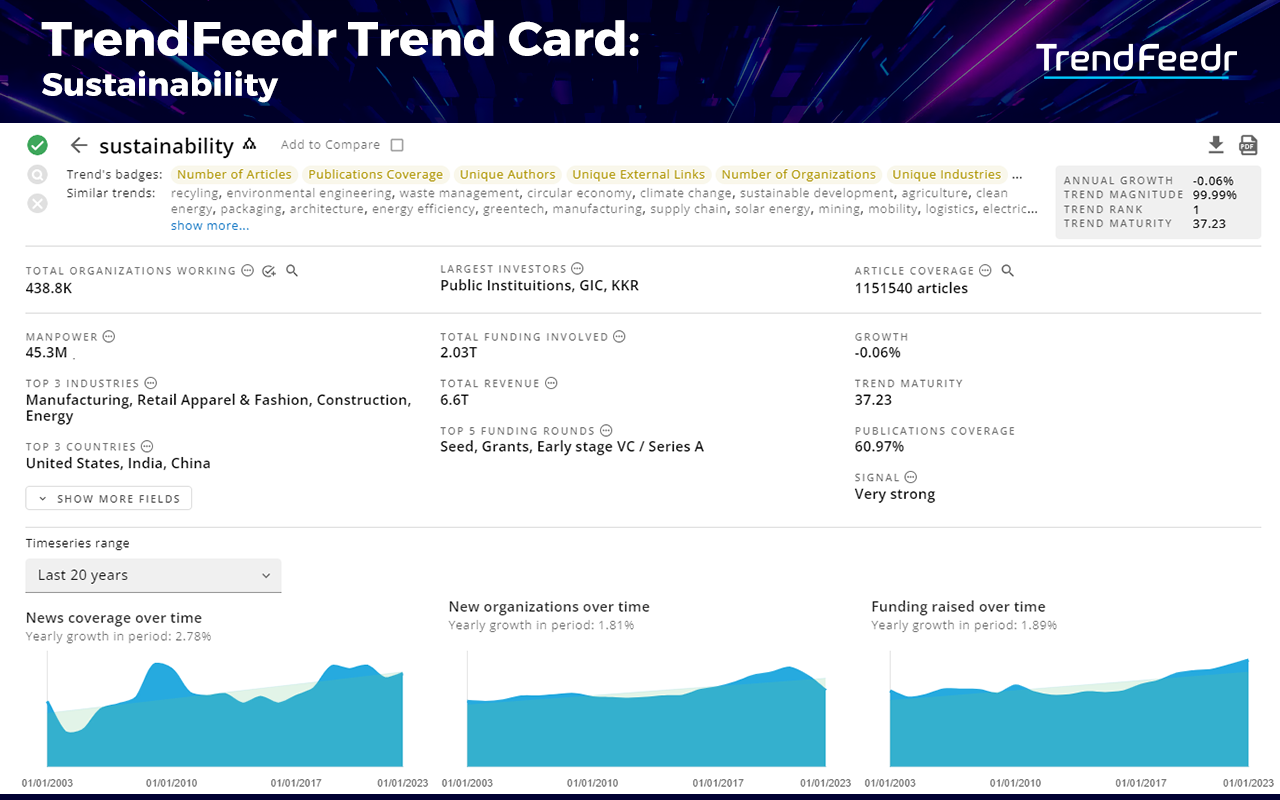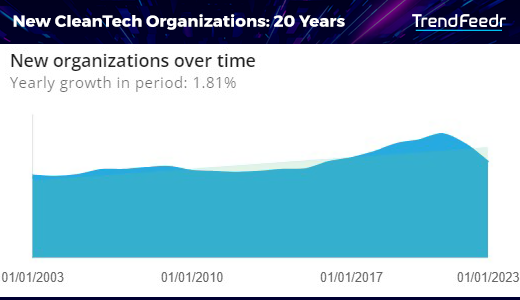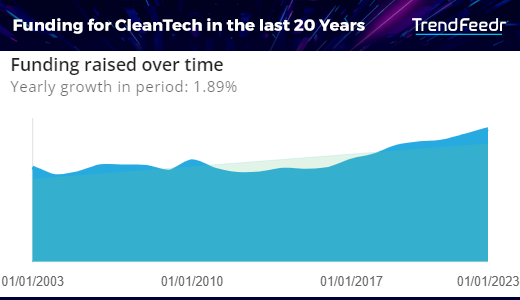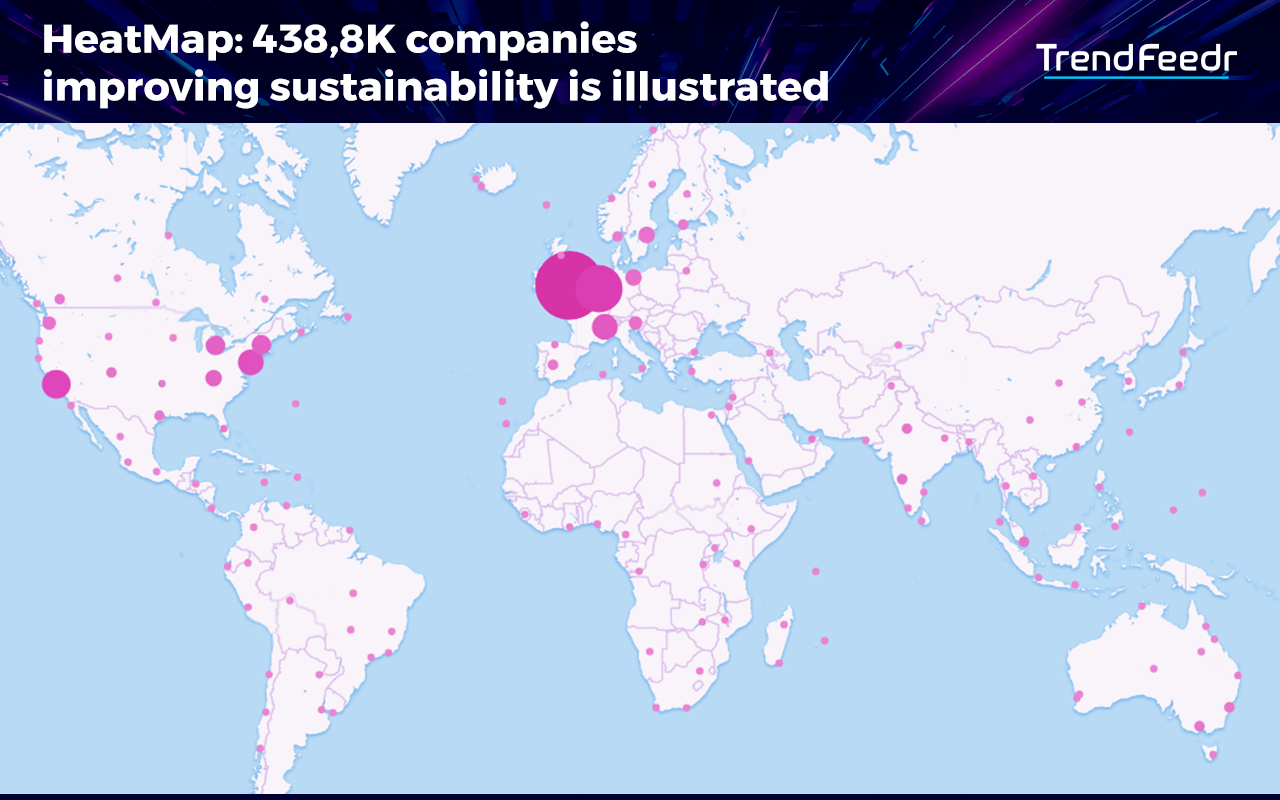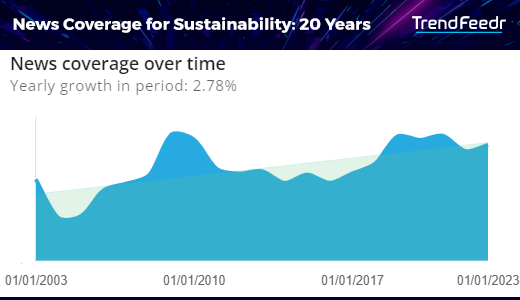Moving towards a sustainable future is not just an option, it is an urgent necessity. The recent Hawaii wildfires highlight the importance of taking sustainability and climate-friendly operations seriously. Creating a green future may start with individual actions but it doesn’t end there. Businesses have a responsibility to consider the economic impact of their actions and the ecological footprint they leave behind. To achieve this transition, it is essential to understand and embrace emerging trends in sustainability. That’s why we created this data-driven deep dive focusing on manifesting sustainability trends like recycling technologies, environmental engineering, clean energy, sustainable agriculture, and eco-friendly packaging. Further, industries are also focusing on other trends in sustainability, including regenerative agriculture, biodiversity conservation, and zero-waste strategies.
Fundamentally, sustainability practices guide us through the pressing challenges of climate change, resource depletion, and societal inequality. This makes them essential for corporate social responsibility (CSR). For example, take Adidas – the global sportswear giant. It launched a line of shoes made entirely from recycled ocean plastic. This initiative was about demonstrating the real-world impact of sustainability trends. It attracted significant consumer attention and appreciation as well as presented a promising business model for profitability and sustainability to coexist.
Interestingly, a recent study from New York University Stern’s Center for Sustainable Business found that products marketed as sustainable grew 5.6 times faster than those that were not. This means that sustainability is now at the core of business innovation.
Therefore, understanding the current trends in sustainability isn’t just good for the planet – it’s good for business. It paves the way for innovative solutions, financial growth, and a resilient, future-proof business model.
Key Takeaways
- Leading Global Trend: Sustainability is the leading trend among 20K+ trends covered by TrendFeedr, with a trend magnitude of 99.99%, and a trend maturity of 37.23%.
- Evolving Technology Trends: Companies focused on sustainability are concurrently working on interconnected trends such as recycling, environmental engineering, clean energy, sustainable agriculture, and eco-friendly or sustainable packaging.
- Company & Funding Landscape: An estimated 438.8K organizations are actively involved in sustainability, with a total funding of $2.03 trillion.
- Prominent investors include Public Institutions, GIC, and KKR, fueling sustainability initiatives.
- Leading sustainability adopters include the United States, India, China, Canada, and Australia, with cities like London, New York City, and Sydney pioneering local initiatives.
- Intensifying Coverage: Media exposure of sustainability witnessed a 2.76% yearly increase over 20 years.
Table of Contents
- Understanding Sustainability: Embracing the Green Future
- Sustainability Performance Analysis – The Role and Influence of Green Future Initiatives
- Main Sustainability Trends & How Companies are Advancing them
- How Sustainability Disrupt Industries
- Governments, Investors, and VCs Investing in Sustainability
- Geographical Activity: Mapping the Global Adoption of Sustainability
- Future Outlook of Sustainability
For this in-depth research of emerging sustainability trends, we leverage TrendFeedr, our all-in-one trend intelligence platform. TrendFeedr identifies future industry and tech trends via advanced, proprietary algorithms. With a focus on trend discovery, clustering, and analysis, the AI-powered platform screens thousands of trends each month to track their development and curate actionable insights.
Among the vast array of over 20K+ trends and technologies monitored by TrendFeedr, sustainability leaves a notable impression. Here’s why:
- Sustainability has emerged as the foremost global trend, ranking number 1. This shows that it is a major concern for businesses and individuals worldwide.
- In comparison to other trends, the sustainability trend has an impressive magnitude of 99.99%, indicating its significant influence and importance. This demonstrates that it is not merely a fleeting interest but rather a topic that is receiving widespread attention and effort.
- The rise of sustainability is further accelerated by increased environmental awareness, green technology advances, and the recognition of long-term economic benefits by businesses and governments.
This article takes you on a deep dive into the current sustainability trends in terms of technology performance, investment, industry impact, regional activity, and future outlook.
Understanding Sustainability: What is the Green Future?
What is sustainability?
In its simplest form, sustainability is meeting current needs without hindering the ability of future generations to meet theirs. It balances economic growth, environmental health, and societal well-being, involving complex interconnections of resource utilization, waste management, and energy efficiency.
Why is sustainability important?
Our planet’s resources are limited, and reckless consumption threatens future generations. Sustainability reduces our ecological footprint and ensures equitable resource distribution. In the face of environmental crises like climate change and biodiversity loss, sustainability is the best defense and survival strategy.
What is sustainability in business?
In a business context, sustainability ensures long-term success while positively impacting society and the environment. It includes ethical sourcing, green manufacturing, employee welfare, and community development. Sustainable businesses recognize their success is linked to the world’s health and prosperity.
For instance, TOMS donates a pair to someone in need of every new pair of shoes sold. This business model appeals to sustainability-conscious consumers who want to make a positive impact with their purchases.
What are sustainable use practices?
Sustainable use practices are actions that preserve resources for future use through smart and efficient resource utilization. In the energy sector, this involves transitioning from fossil fuels to renewable sources such as solar and wind. Sustainability in agriculture promotes the adoption of organic farming techniques that improve soil health and biodiversity.
Sustainability is a science supported by innovative technologies. AI-powered energy grids, blockchain-based supply chains, and even simple technologies like drip irrigation all play crucial roles in promoting sustainability.
Companies like Interface and Tesla are leading the way in sustainable practices. Interface aims for zero negative impact on the environment through initiatives like ‘Mission Zero,’ while Tesla is revolutionizing the automobile industry with electric vehicles (EVs).
Sustainability Performance Analysis – How Impactful are Green Future Initiatives?
Presented in the TrendFeedr Trend Card below is a comprehensive visual guide detailing the latest sustainability trends. This snapshot encompasses a wide spectrum: from pioneering organizations dedicated to environmental change to the most substantial investors propelling the green revolution. We’ve collated data on the industries making waves in sustainability, key articles that shed light on current happenings, and the total funding pouring into eco-conscious initiatives. Additionally, get a clear view of the growth trajectory in this sector and see how the media is amplifying the message.
Sustainability itself is a rapidly growing trend, with a trend magnitude of 99.99%, it ranks as the top 1 of all trends covered by the trend management tool TrendFeedr, reflecting its tremendous relevance and widespread attention. With a trend maturity of 37.23 out of 100, sustainability has established itself as a key concept in today’s world. However, this score also indicates that there is significant potential for innovation and growth in this field.
Looking for all trends related to sustainability?
Main Sustainability Trends & How Companies are Advancing Them
438.8K companies that engage in sustainability practices often expand their efforts into related environmentally friendly trends. Here’s an overview of the pivotal trends within sustainability and a look at varied approaches adopted by these global organizations to ensure sustainable development:
Recycling
- Recycling, a process in waste management, diverts materials from landfills and reintroduces them into production.
- Essential for sustainability and crucial to the circular economy, this trend minimizes waste and reduces the strain on our planet’s finite resources.
- The recycling trend is gaining traction, with 129.2K organizations involved in waste reduction and resource conservation efforts.
- These organizations have received $222.7B in funding and employ around 9.5M people, all working to convert waste into valuable resources.
Environmental Engineering
- Environmental engineering involves the application of scientific and engineering principles to address environmental challenges.
- Innovative solutions to environmental challenges are being developed by approximately 3368 organizations specializing in environmental engineering.
- These organizations have secured around $2.3B in funding and employ a workforce of 285.1K individuals.
- They are designing and implementing sustainable solutions to minimize environmental damage and create a better future.
Clean Energy
- Clean energy, or green energy, refers to energy sources with minimal negative impacts on the environment.
- The shift towards renewable energy solutions like solar, wind, and hydroelectric power is essential in the face of climate change.
- An impressive 9495 organizations are driving this trend, reducing greenhouse gas emissions and reliance on fossil fuels.
- These organizations have harnessed substantial funding of $124.4B, and employ a workforce of 702.2K, pushing the boundaries of renewable energy solutions.
Sustainable Agriculture
- Sustainable agriculture focuses on making farming environmentally friendly, economically viable, and socially just.
- It includes organic farming that avoids synthetic chemicals and genetically modified organisms.
- At the same time, regenerative agriculture takes it a step further by rejuvenating the soil, enhancing biodiversity, and restoring ecosystems.
- The sustainable agriculture trend is not far behind, with 2818 organizations planting the seeds for a green future.
- These organizations have attracted total funding of $10.8B and employ 217.3K people, championing sustainable farming methods to ensure our agriculture doesn’t harm our planet.
Eco-friendly Packaging
- Sustainable packaging emphasizes the use of materials and designs that minimize environmental impact.
- A notable innovation in this realm is compostable packaging – which breaks down into natural elements in a compost environment, leaving no toxic residue.
- The trend of sustainable packaging is gaining momentum, with 3106 organizations at the forefront.
- These organizations have attracted total funding of $12.8B and employ a collective manpower of 377.6K, ensuring that the products we consume come in environmentally-friendly packages.
These core sustainable technology trends underscore the multidimensional approach companies are taking to address global warming. It reflects a broader shift in corporate strategies towards more comprehensive and inclusive sustainability models, which will drive future innovations in this field.
How Sustainability Disrupts Industries
Sustainability is reshaping many industries. Let’s dive into the top seven sectors where its impact is especially notable.
Manufacturing
Sustainable practices in the manufacturing sector focus on reducing waste, increasing energy efficiency, and promoting the use of renewable resources. For example, Unilever, a leading company in the consumer goods manufacturing industry, has committed to achieving a deforestation-free supply chain by 2023.
Retail Apparel and Fashion
The negative environmental impact of fast fashion has sparked a shift towards more sustainable practices within the industry. Leading brands such as Patagonia and Stella McCartney are embracing circular fashion principles by promoting clothing recycling and utilizing eco-friendly materials.
Construction
The construction industry is making strides toward sustainability by adopting green building practices. Leading companies such as Skanska and Lendlease are at the forefront of this movement, incorporating energy-efficient technologies and sustainable materials in their projects. This shift towards eco-friendly construction is a positive trend that is reducing the industry’s carbon emissions.
Energy
The energy sector is arguably undergoing the most significant transformation as it moves away from fossil fuels and towards renewable sources such as wind, solar, and hydroelectric power. This shift towards CleanTech is being led by companies like NextEra Energy and Ørsted, who are making substantial investments in renewable energy infrastructure. This trend towards green energy sources is a positive development for the industry and the environment.
Agriculture
Sustainable agriculture is gaining momentum as more and more farmers adopt practices such as organic farming and permaculture. This approach prioritizes soil health, biodiversity, and ecological balance. Companies like Bowery Farming are leveraging indoor farming technology to grow pesticide-free produce while using 95% less water than traditional agriculture.
Transportation
The transportation industry is undergoing a revolution with the adoption of electric vehicles and a focus on enhancing fuel efficiency being key trends. Tesla‘s success in the EV market serves as a prime example of how sustainability is driving change in this sector. This trend is expected to continue, with more companies investing in climate-friendly transportation solutions.
Information Technology
The IT industry is taking significant steps towards sustainability by reducing e-waste and energy consumption through initiatives such as server virtualization and cloud computing. Tech giants like Google and Microsoft have made commitments to become carbon-neutral or carbon-negative, highlighting the importance of sustainability in this industry.
These examples demonstrate that sustainability is not just a trend, but a driving force for transformation across industries. It is spurring innovation and economic growth while also safeguarding the future of our planet.
Organizations Pioneering Sustainability
Over the last 20 years, there has been significant growth in the number of new organizations dedicating their focus to sustainability, with a yearly increase rate of 1.81%. This demonstrates the expanding influence of sustainability as an integral part of corporate strategies and business operations, further underscoring the longevity of this trend.
Here’s a compilation of the top 5 new organizations founded in the last 3 years:
- MiniMines – A cleantech company that provides sustainable recycling solutions.
- SOLARCYCLE – A solar design and recycling platform that maximizes solar sustainability and promotes a circular economy for solar and renewable energy.
- Cetogenix – A waste conversion technology company that develops sustainable services to address climate change on a global scale.
- Technology Minerals – A company that addresses the circular economy in the battery metals sector, covering the entire mineral life cycle from exploration and mining to end-of-product recycling.
- CiRCLR – A company that builds a waste processing platform leveraging AI and blockchain to reuse and reduce waste from operations.
Governments, Investors, and VCs Investing in Sustainability
Sustainability is attracting significant financial attention and investment, with its total funding ranking in the top 5% of all 20K+ trends.
Topping the chart of investors is Public Institutions, with investments in 949 organizations, totaling an estimated $78.5B. Their top investments include ADNOC Gas with a significant $2.5B.
Following them is GIC, with investments in 40 organizations totaling an estimated $21.9B, including Ant Group with a massive $14B and Greenko Group with $1.8B.
KKR also makes a significant contribution with investments in 35 organizations, amounting to $10.4B. This includes the $6.4B investment in Marelli and $3.1B in MASMOVIL.
The significance of sustainability is further underscored by the unique investors in this sphere, who have ranked it among the top 5% of all trends.
Over the last 20 years, investments in sustainability-focused initiatives have seen an appreciable growth rate of 1.88% yearly. This persistent increase in funding underscores the conviction of investors in the long-term value of sustainability, indicating its crucial role in the economic landscape of the future.
The sustainability trend is experiencing growth not only in numbers but also in human capital, with a total manpower of 45.3M and an average team size of 133. The median team size is 18, indicating the involvement of diverse organizations, from small sustainability startups to large corporations.
The total yearly employee growth in this area has reached 2.4M, with an average growth rate of 8 and a median of 2, highlighting the increasing job opportunities and economic and societal benefits created by this trend.
Funding Trends for Sustainability-driven Companies
The sustainability market has experienced consistent growth in recent years, with global sustainability market size and investment steadily increasing. This reflects a shift in consumer preferences towards more sustainable options and also a growing recognition among businesses of the importance and potential profitability of sustainable practices.
Data from TrendFeedr shows that total funding of sustainability projects has reached $2.03T, with an average funding amount of $35.8M and a median of $1.6M. These figures demonstrate that investors are increasingly viewing sustainability investing as a financially viable opportunity.
In terms of revenue, TrendFeedr estimates that the sustainability sector has generated a total of $6.6T, with an average revenue of $19.2M and a median of $2.7M. These numbers highlight the economic viability and profitability of sustainable business models.
A diverse range of financial instruments is being used to fund sustainability initiatives, including seed funding, grants, early-stage VC/Series A funding, accelerator/incubator funding, and venture rounds. Grants account for a significant portion of funding methods, with 2.22% of sustainability companies having secured a total of 14,316 grants.
Geographical Activity: Mapping the Global Adoption of Sustainability
The global distribution of the 438.8K companies adopting sustainability into their business models is illustrated in the heat map below.
Interested to explore all 438K+ sustainability companies?
Sustainability initiatives led by the US continue to dominate, with significant advancements across various sectors. Businesses and institutions alike are prioritizing sustainability in their operations, fueling further growth and innovation. India and China are making strides in sustainable development despite their economic and population size. Canada and Australia are also making substantial progress, their commitment to environmental responsibility is reflected in their national policies, initiatives, and the growth of sustainability-focused businesses.
Major metropolitan areas such as London, New York City, Sydney, Melbourne, and Singapore are leading the charge in urban sustainability efforts. These cities host a high concentration of organizations dedicated to sustainable practices, fueling local economies while leading global sustainability efforts. Their continued efforts highlight how sustainability has become a global social goal, transcending borders and cultures.
Sustainability’s Media Exposure soars with a 2.78% Yearly Increase over 20 years
Sustainability trends have been consistently gaining visibility in media coverage over the last two decades. In fact, the average yearly sustainability news coverage has increased by 2.78% and it has an absolute growth of 73.05%. This frequent appearance of sustainability in the media highlights its ongoing relevance and importance, not just in corporate settings but also in the wider public discourse.
On top of that, sustainability has seen significant attention in publication coverage, falling in the top 5% of all 20K+ trends covered by TrendFeedr. The number of articles centered around the sustainability trend also occupies a position in the top 5% of all trends, with 1151540 articles between 2003 and 2023.
Future Outlook of Sustainability
As the global community grapples with the pressing challenges of climate change, resource depletion, and social equity, the future of sustainability emerges as a focal point of discussion and action. Here’s a look at what it may hold based on current trajectories and data:
Rise of Circular Economy
The linear model of production and consumption has led to significant waste and inefficiency. The trend towards a circular economy, where waste is minimized and resources are continuously reused, is expected to accelerate in the future. This shift will be driven by both environmental necessity and the financial benefits of resource efficiency.
Policy and Regulatory Changes
As the impact of climate change becomes increasingly apparent, it is likely that governments around the world will enact more stringent regulations around sustainability. In response to these changing regulations, businesses will need to adapt their practices. Those that have already prioritized sustainability are likely to be best positioned to thrive in this new regulatory environment.
Innovation and Technology
Advances in technology are expected to continue to play a pivotal role in enabling more sustainable practices across industries. From the use of AI and machine learning to improve energy efficiency to the application of biotechnology in promoting more sustainable processes, the future of sustainability is closely linked with technological innovation. As technology continues to evolve, it is likely that new and innovative solutions, like carbon capture, will emerge to address the challenges of sustainability.
Consumer Demand
Traditional consumer goods and services often neglect environmental considerations. As consumers become increasingly environmentally conscious, their demand for sustainable products and services is set to grow. This consumer pressure is expected to continue to be a major driver of sustainability across all sectors.
Sustainable Jobs
With the growing focus on sustainability, there is likely to be an increase in jobs related to this field. From renewable energy technicians to sustainability consultants, these jobs will drive the transition towards sustainability and also contribute to economic growth.
How to Keep Up with the Advancements in the Sustainability Landscape?
As the sustainability landscape continues to evolve, it is essential to stay up-to-date with the latest advancements. The future of sustainability looks promising, with continuous innovations from all stakeholders leading us toward a more sustainable future.
By keeping abreast of these developments, you can evolve your business strategies to align with the changing market and stay ahead of the competition. But how can you do this? One way is to subscribe to industry publications, engage with industry-specific forums, follow thought leaders, and attend trade shows and conventions. Another effective way is to utilize a trend intelligence platform like TrendFeedr to keep up with emerging and future sustainability trends.
By staying informed about the latest developments in sustainability, you can make crucial business decisions that meet the future needs of the market.

